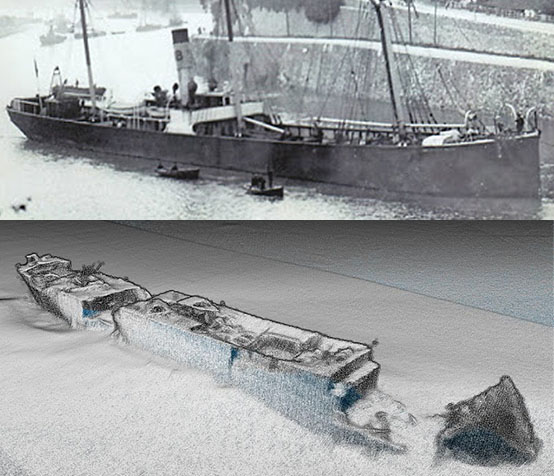A team of scientists led by Dr Ruth Plets, School of Environmental Sciences at Ulster University, aboard the Marine Institute's Celtic Voyager research vessel has revealed detailed images of World War I shipwrecks in the Irish Sea.
The team set out to capture the highest resolution acoustic data possible of WWI shipwrecks lost in the Irish Sea, using a new multi-beam system (EM2040) on board the RV Celtic Voyager to get the best data ever acquired over these
wrecks.
"We were able to capture the most detailed images of the entirety of the wrecks ever. Some of the wrecks, which are too deep to be dived on, have not been seen in 100 years. So this is the first time we can examine what has happened to them, during sinking and in the intervening 100 years, and try to predict their future preservation state," explained Dr Plets.
Among the shipwrecks surveyed were the SS Chirripo, which sank in 1917 off Black Head (Co. Antrim) after she struck a mine; the SS Polwell, which was torpedoed in 1918 northeast of Lambay Island; and the RMS Leinster, which sank in 1918 after being torpedoed off Howth Head when over 500 people lost their lives – this was the greatest single loss in the Irish Sea.
Dr Peter Heffernan, CEO Marine Institute welcomed the achievements of the survey, supported by the competitive ship-time programme: "The multidisciplinary team is making an important contribution to understanding and protecting our maritime heritage and to our ability to manage our marine resource wisely".
Explaining how the survey was carried out Dr Plets said, "We moved away from traditional survey strategies by slowing the vessel right down to allow us to get many more data points over the wreck, with millions of sounding per
wreck."
"The detail is amazing as we can see things such as handrails, masts, the hawse pipe (where the anchor was stored) and hatches. Some of the vessels have split into sections, and we can even see details of the internal structure. With the visibility conditions in the Irish Sea, no diver or underwater camera could ever get such a great overview of these wrecks."
As well as acoustic imaging, the team collected samples from around the wreck to see what its potential impact is on the seabed ecology. Sediment samples were also taken for chemical analysis to determine if these wrecks cause a
concern for pollution.
The project is carried out to coincide with WWI centenary commemorations, noted Dr Plets, "We often forget the battles that were fought in our seas; more emphasis is put on the battles that went on in the trenches. However, at least 2,000 Irishmen lost their lives at sea, but unlike on land, there is no tangible monument or place to commemorate because of the location on the bottom of the sea,"
"In the Republic of Ireland there is a blanket protection of all wrecks older than 100 years, so all these will become protected over the next few years.
To manage and protect these sites for future generations, we need to know their current preservation state and understand the processes that are affecting the sites," Dr Plets further stated.
The next step for the team is to use the data collected to create 3D models which can be used for archaeological research, heritage management and dissemination of these otherwise inaccessible sites to the wider public.
"There is so much data, it will take us many months if not years, to work it all up. Some of the wrecks are in a very dynamic environment and we are planning to survey these vessels again next year to see if there is a change, especially after the winter storms. That will give the heritage managers a better idea if any intervention measures need to be taken to protect them," said Dr Plets.
"These data could well signal a new era in the field of maritime archaeology. We hope it will inspire a new generation of marine scientists, archaeologists and historians to become involved. Above all, we want to make the general public, young and old, aware of the presence of such wrecks, often located only miles off their local beach."
The research survey was supported by the Marine Institute, through its Ship-Time Programme, funded under the Marine Research Programme by the Irish Government.
The diverse team included maritime archaeologists Rory McNeary, from the Northern Ireland Department of the Environment, and Kieran Westley, from the University of Southampton; geologists Rory Quinn and Ruth Plets, both Ulster University; biologists Annika Clements, from Agri-Food and Biosciences Institute, and Chris McGonigle, from Ulster University; Ulster University Marine Science student, Mekayla Dale; as well as hydrographer Fabio Sacchetti from the Marine Institute who works on Ireland's national seabed mapping programme, INFOMAR, run jointly with the Geological Survey of Ireland.
































































